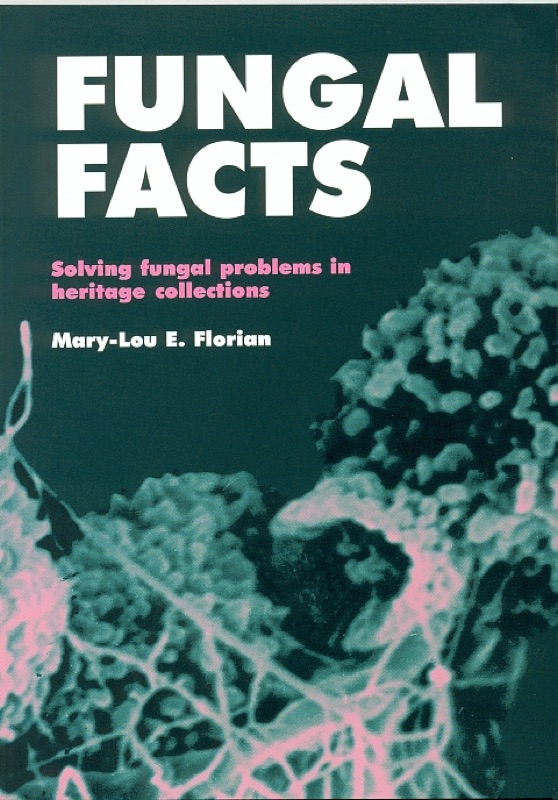Prevention costs so little in comparison to the cost of recovery and the health hazards that will ensue from a fungal infestation.
Many of those involved in the care of collections have experienced fungal infestations ranging from localised outbreaks to major catastrophes brought about by flood or the aftermath of fire. This book aims to provide collection managers, conservators, and museum and gallery personnel with biological information on fungi and strategies for both preventing infestation and controlling/eradicating an infestation once it has occurred. Importantly, throughout the text the author addresses the safety issues and the major concerns of health hazards caused by fungal infestations, issues that are covered more specifically in the chapter on monitoring for air quality and surface contamination.
The effects of fungal infestation on paper, textiles, leather, wool and wood are outlined, with emphasis placed on the methods of recovering objects that are infested, preventive conservation methods, risk assessment and disaster preparedness.
The reader will find answers to frequently asked questions such as:
-What are fungi?
-Where do they come from?
-What do they look like?
-Why are they growing?
-What is an infestation?
-How can infested material be treated?
-What is needed for prevention, monitoring and risk assessment?
-How does one prepare for an environmental disaster?
-Following a disaster, how can a fungal infestation be prevented?
Fungal Facts provides a basis for understanding and solving fungal problems in objects and collections. It is essential reading for all those charged with the care and management of cultural property.
Introduction
The manual
What are fungi? Classification and nomenclature
Where do they come from?
The culprit, conidium: what does it look like and what does it do?
Germination and vegetative growth of fungi: why is it happening and can we control it?
What's in a fungal infestation and what is its effect on the materials of heritage objects?
Collection recovery - removing fungal structures from heritage objects
Monitoring for air quality and surface contamination in museums and archives: a review
Prevention, disaster preparedness and summary
Who are fungi? Classification and nomenclature
Classification: introduction
Nomenclature
Prokaryotes and Eukaryotes
The fungi in the kingdoms Protoctista and Eumycota
The true fungi (Eumycota) classification
Overview
Subphylum Ascomycotina and Basidiomycotina
Subphylum Basidiomycotina (Basidiomycetes) - the wood digesters
Comparison of life cycles of some fungi isolated from heritage objects
Identification methods
Culturing
Molecular taxonomy and immunology
Where do they come from?
Sources
Airspora, aerospora, bioaerosols
Fungal species related to heritage artifacts
Sources of contaminants on heritage objects
Determining the causative species - who is the culprit?
The culprit, conidium: what does it look like and what does it do?
Introduction
Structure of a conidium
The conidial developmental stages
Maturation and dormancy of conidia
Maturation
Causes of dormancy in conidia
Control of dormancy
Activation of conidia
Introduction
Activation treatments
Dormancy and activation: survival mechanisms
Conservation implications of activation
Deactivation
Survivability - how long do conidia survive?
Germination and vegetative growth of fungi: why is it happening and can we control it?
Introduction - conidia germination and growth
Water relationships: the concepts and potential for fungal control
Where's the water?
Water vapour: absolute humidity and relative humidity (RH) of the air
Water in materials
Water in fungal structures, conidia and hyphae moisture content (MC): the water of life!
Controlling fungal activity by water relationships
Temperature, the gases, pH and light: their effects on and potential in control of fungal activity
Temperature effects on germination and growth
High temperature
The effects of low temperatures and freezing on fungi and potential control
Oxygen and carbon dioxide
Hydrogen ion concentration (pH)
Light
Nutrients
What's in a fungal infestation and what is its effect on the materials of heritage objects?
Introduction
Chitin and beta-glucans in fungal cell walls
Metabolic products excreted into substrate and in fungal structures
Melanin and other brown pigments
The colorful pigments
Organic acids
Enzymes
Proteins, free amino acids and sugars
Lipids and glycerol
Chelated metals
The effects of fungal growth on materials
Paper and textile materials
Protein material: leather and wool
Wood
Other materials
Collection recovery - removing fungal structures from heritage objects
Introduction: an overview
Aseptic techniques: preventing an increase of surface contamination and airborne fungal structures during collection recovery
Drying in situ and temporary storage of fungal-infested wet materials
Introduction
Dehydration in situ at room temperature or higher
Refrigeration
Freezing: effects of storage at freezing temperatures used to prevent fungal growth on water-soaked organic materials
Freeze-drying effects on material and fungi
Summary
Other methods of killing fungal structures
Fungicides
High-energy irradiation
Low-oxygen environments
Monitoring for air quality and surface contamination in museums and archives: a review
Bioaerosols and surface samples
Introduction
Bacteria and their endotoxins
Fungal components in a bioaerosol: fungal structures, beta-glucans, mycotoxins and microbial volatile organic compounds (MVOCS)
Monitoring or air sampling methods for bioaerosols
Goals
Monitoring equipment
Interpretation of the results and biases of the tests
Risk assessment of environments in a museum/heritage site and fungal infestations
Prevention, disaster preparedness and summary
Preventing an infestation
Elimination/prevention of airborne fungal structures settling on heritage objects
Elimination of fungal contamination in solutions and ancillary materials used in, on or adjacent to artifacts
Prevention of the activation of conidia
Prevention of the germination of conidia
Prevention of vegetative growth
Prevention of contamination during collection recovery
The use of aseptic techniques during cleaning or recovery of fungal-infested heritage objects
Monitoring as a help in prevention
Prevent the problem - water
Disaster preparedness
Summary
Be prepared
Procedures for a small fungal infestation of dry heritage objects
Procedures for a large fungal infestation of wet heritage objects
Glossary
Bibliography
Index
